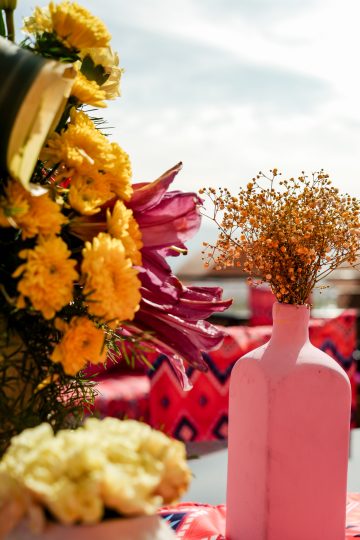Weaving Love: Your Guide to South Indian Wedding Traditions – Tamil, Telugu & Kerala Customs
As wedding planners in Jaipur, we’ve seen grand celebrations from across India, and there’s an undeniable charm and deep-rooted cultural significance to South Indian wedding traditions. Unlike the often boisterous and lengthy North Indian affairs, weddings in the South are typically characterized by their profound spirituality, traditional elegance, and focus on ancient rituals, often taking place at auspicious “muhurtams” (auspicious times) in the early morning.
While each South Indian state boasts its own distinct customs, the core values of family, respect, and spiritual union remain paramount. Let’s delve into the beautiful intricacies of Tamil, Telugu, and Kerala wedding customs, offering you a glimpse into these rich cultural tapestries.
The Heart of South Indian Weddings: Common Threads
Before we explore the unique aspects, let’s highlight some beautiful commonalities you’ll find across most South Indian weddings:
- Emphasis on Rituals: The ceremonies are deeply symbolic, with each step holding profound meaning, often rooted in Vedic traditions.
- Auspicious Timings (Muhurtam): The timing of the wedding ceremony is meticulously chosen by an astrologer, often at dawn, for maximum prosperity and happiness.
- Bridal Attire: The Silk Saree: The South Indian bride traditionally adorns herself in a resplendent silk saree – Kanjivaram (Tamil Nadu), Gadwal or Pochampally (Telangana/Andhra Pradesh), or Kasavu (Kerala) – often in vibrant hues like red, gold, green, or cream, paired with exquisite gold jewelry, including “Temple jewelry.”
- Groom’s Attire: Dhoti/Veshti: The groom typically wears a white or cream dhoti (or veshti in Tamil), often with a silk shirt or angavastram.
- Floral Decor: Fresh flowers, especially fragrant jasmine and marigolds, are extensively used, adorning everything from the mandap to the bride’s hair (gajras). Banana leaves and traditional motifs are common.
- Vegetarian Feast (Sadhya): The wedding feast is often a lavish vegetarian spread, traditionally served on banana leaves, showcasing the region’s culinary richness.

Tamil Wedding Traditions: Elegance and Symbolic Depth
Tamil weddings are known for their simplicity, adherence to rituals, and a strong emphasis on cultural purity.
Key Tamil Wedding Rituals:
- Panda Kaal Muhurtham: A pre-wedding prayer performed by both families to seek blessings from deities and ancestors for a smooth wedding.
- Sumangali Prarthanai: Married women (Sumangalis) from the bride’s family are invited and worshipped, seeking their blessings for a long and happy married life for the bride.
- Naandi Shraddham: A ceremony to honor and seek blessings from the ancestors.
- Nischayathartham (Engagement): A formal ceremony where families exchange gifts and rings, officially announcing the alliance.
- Mangala Snanam: A purifying holy bath for the bride and groom at their respective homes on the wedding morning, preparing them for the sacred union.
- Gauri Puja: The bride worships Goddess Gauri (Parvati) for a happy and prosperous married life.
- Kashi Yatra: A playful ritual where the groom pretends to embark on a pilgrimage to Kashi to renounce worldly life, only to be persuaded by the bride’s father to marry his daughter. It symbolizes his transition from bachelorhood to a householder.
- Maalai Maatral: The bride and groom exchange garlands three times, signifying their acceptance of each other as life partners. This is often a fun, playful moment where family and friends lift the couple to make it harder.
- Oonjal: The couple sits on a swing (Oonjal) and are gently rocked, while elderly women circle them with lamps and sing traditional “Laali” songs. This symbolizes the ups and downs of life and the family’s support.
- Kanyadaanam: The deeply emotional moment where the bride sits on her father’s lap, and her father places her hand into the groom’s, formally “giving her away.” The bride’s mother often pours holy water over their joined hands.
- Muhurtham (Thaali Kattu): The most significant ritual where the groom ties the sacred “Thaali” (Mangalsutra, a yellow thread with a gold pendant) around the bride’s neck with three knots, symbolizing their lifelong commitment and spiritual, mental, and physical union.
- Saptapadi: The couple takes seven sacred steps around the holy fire, each step representing a vow for their marital journey (e.g., prosperity, happiness, family, mutual respect).
- Ammi Midithal: The bride places her right foot on a grinding stone while the groom holds her toe, symbolizing her strength and resilience in facing life’s challenges.
Grihapravesham: The bride’s ceremonial welcome into the groom’s home, often with an Aarti performed by the groom’s mother.
Telugu Wedding Traditions: Spirituality and Grandeur
Telugu weddings, particularly from Andhra Pradesh and Telangana, are known for their spiritual focus, vibrant decor, and some truly unique rituals.
Key Telugu Wedding Rituals:
- Nischitartham (Engagement): Similar to Tamil, this is the formal engagement with ring and gift exchanges, and the fixing of the wedding date.
- Pelli Kuthuru / Pellikoduku: The Haldi (turmeric) and oil application ceremony for the bride and groom at their respective homes, followed by a purifying bath (Mangala Snanam).
- Snathakam: The groom takes a ritualistic bath and wears a sacred silver thread, marking his transition from bachelorhood to a householder.
- Kashi Yatra: Similar to Tamil weddings, the groom pretends to embark on a spiritual journey but is convinced to marry.
- Ganesh Puja & Gauri Puja: Performed separately by the groom and bride to seek blessings from Lord Ganesha (remover of obstacles) and Goddess Gauri (for fertility and marital bliss).
- Bride’s Entry (sometimes in a basket): In some communities, the bride is brought to the mandap in a beautifully decorated wicker basket by her maternal uncles, symbolizing her as a precious offering. A curtain (Terasala) is often placed between the bride and groom until a specific ritual.
- Kanyadanam: The bride’s parents wash the groom’s feet and formally offer their daughter’s hand to him, with the groom promising to cherish and protect her.
- Jeelakara Bellam: A highly significant ritual where the bride and groom (still separated by the curtain) place a paste of cumin seeds (Jeelakara) and jaggery (Bellam) on each other’s heads. This symbolizes their inseparable union through all the bitter and sweet phases of life. The curtain is removed only after this.
- Mangalsutram (Tying of the Sacred Thread): The groom ties a sacred yellow thread, typically with two gold pendants (bottu), around the bride’s neck with three knots, symbolizing their union and his commitment.
- Talambralu: A fun and joyous ritual where the bride and groom shower each other with rice mixed with turmeric, pearls, and sometimes thermocol balls. This symbolizes showering each other with happiness, prosperity, and blessings.
- Sthalipaka: The maternal uncle adorns the bride’s second toe with a silver toe ring.
- Saptapadi: The couple takes seven steps around the sacred fire, making their vows.



Kerala Wedding Traditions: Simplicity and Elegance
Kerala weddings, particularly Hindu Malayali weddings, are renowned for their simplicity, elegance, and deep respect for tradition, often taking place in temples or elegant halls, focusing on core rituals.
Key Kerala Wedding Rituals:
- Muhurtam (Fixing the Auspicious Time): An astrologer consults the horoscopes to determine the most auspicious time for the wedding.
- Nischayam (Engagement): A formal ceremony where families exchange horoscopes, rings (Mothiram Maral), and gifts, officially sealing the alliance.
- Madhuparkam Ritual: The groom arrives at the venue and is warmly welcomed by the bride’s family. The bride’s father washes the groom’s feet, and the groom presents a white saree (Manthrakodi) to the bride to wear during the wedding.
- Thalikettu Kalyanam (Tying the Thali): The most significant ritual. The groom ties the sacred “Thali” (a small gold pendant on a yellow string or a gold chain) around the bride’s neck, symbolizing their marital union and lifelong commitment. This is often followed by the exchange of garlands.
- Pudamuri (Gifting the Wedding Saree): The groom gifts the bride the Kasaavu saree (often a white or cream silk saree with a gold border) that he brought during the Madhuparkam ritual, symbolizing his commitment to provide for her.
- Kanyadaanam: The bride’s father places her hand in the groom’s, entrusting her to him. This ritual happens around the holy fire (Veli).
- Saptapadi: The couple takes seven steps around the sacred fire, making their vows.
- Sparsham Ritual: The bride and groom sit facing each other, gently touching foreheads, symbolizing their union. The bride also performs a ritual of throwing rice into the fire and placing her foot on a grinding stone (Ammi), signifying her transition and acceptance of new responsibilities.
- Kudivep & Grihapravesh: The bride is welcomed into her new home by the groom’s mother, often carrying a traditional lamp (Nilavilakku) to symbolize bringing light and prosperity into the new household. Unlike North Indian weddings, there is typically no emotional “Vidaai” (farewell) ceremony.
Embracing South Indian Traditions in Your Wedding
Whether you’re a South Indian couple wanting to honor your heritage or a non-South Indian couple captivated by these beautiful customs, incorporating these traditions can make your wedding truly special. Work with experienced wedding planners and local priests who understand the nuances of these rituals.
The beauty of South Indian weddings lies in their spiritual depth, cultural richness, and the timeless elegance they exude. Each tradition, from the sacred fire to the intricate jewelry, tells a story of love, commitment, and the blending of two families into one.

